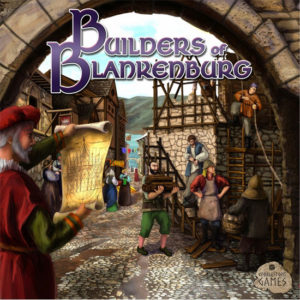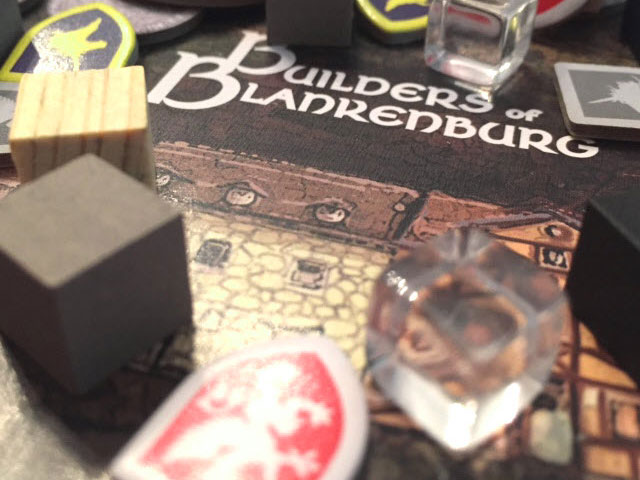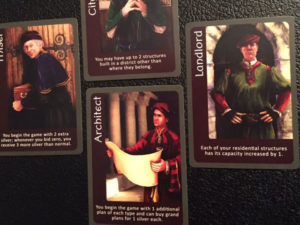 Have you ever discovered a hidden treasure, something you didn’t expect to ever find but when you did, your heart skipped a beat. This happened when I played the Builders of Blankenburg for the first time. It was like opening, smelling and tasting a vintage, fine wine after it was once thought lost in the dark recesses of the old cellar.
Have you ever discovered a hidden treasure, something you didn’t expect to ever find but when you did, your heart skipped a beat. This happened when I played the Builders of Blankenburg for the first time. It was like opening, smelling and tasting a vintage, fine wine after it was once thought lost in the dark recesses of the old cellar.
Builders of Blankenburg is published by the Cobblestone Games and first-time-designer Peter Schultz. It is a game for 2-5 players that plays in 60-90 minutes.
Game Overview:
The title of “Builder of Blankenburg” gives away its intent. This euro-style game focuses on building structures with income and resource management required to support that activity.
In Builders of Blankenburg, players vie with each other to construct the most prestigious structures of 4 different types: Civic, Commercial, Religious and Residential. They do this by obtaining and paying specific resources required to construct each structure from plans they purchased during the game.
The players are also attempting to entice the townsfolk to stay at their structures by matching the townsfolk’s list of preferred building.
Game Components:

The production quality of the board, cards and cardboard components are excellent. The cards are linen-finished and appear to be able to hold up well, even with periodic shuffling. The resources are wooden or plastic and are chunky and nice to hold and handle.
An exceptional feature of this game is its art. The game board depicts Middle Ages Blankenburg, with new construction going on all over the town. The game board is two-sided and the other side depicts a sketch of the city which looks like a set of building plans. The cards all have unique art and depict the people and the buildings they lived in during the period.
How to Play:
Players begin the game with 1-wood, 1 stone and 12 silver coins. They also are dealt 1-starting basic plan and 1-character card (giving them a unique benefit).
Each turn consists of 4 Phases:
-

The Resource dice are used to seed the Bidding Wheel each turn. Bidding: The first player seeds the Bidding Wheel with a number of different resources equal to one less than the number of players. Then the first player rolls the resource dice. Depending on the result of the dice roll, the first player will finish seeding the Bidding Wheel. Players then secretly choose an amount of silver coins to bid. In highest bid order, player’s selects up to 3 resources of one type from the Bidding Wheel. Any resources left on the Bidding Wheel after the bidding is resolved are left on the Bidding Wheel. Players who opt out of bidding receive 3 silver coins from the general supply.
- Building: Starting with the first player and rotating clockwise, each player has an opportunity to build plans in their hand by paying their resource cost and placing the newly built structure on the game board. Players may demolish structures and build another structure in its place if the new structure has a higher prestige value. Players can also repair damaged structures at this time by paying the appropriate cost.
- Income: Income is paid to players in silver coins based on the income value of the structure that was visited by each active townsfolk (citizens and visitor). The active visitor, then citizens (in numbered order – highest to lowest) decide to stay at structures they prefer. If none are available, they will stay at an inn. Structures have occupancy limits and may become unavailable to stay at if they become full.
- Marketplace: Starting with the first player and rotating clockwise, each player has the opportunity to purchase basic or grand plans (to build) and available resources from the marketplace. The players may also sell as many resources back to the marketplace as they wish, but there is a limit to how many of each resource the marketplace may contain. Other free actions can be performed by the players during their turns like completing quests, obtaining incident cards, or playing incident cards and crafted items for their one-time bonuses.
The game end is triggered when:
- There are no places left on the game board to build structures
- The last spot on the citizen track has been occupied by a citizen
Players add to their current prestige score by gaining prestige points from leftover resources, coins and owning the most of each structure type. Players also lose points for damaged structures. The player with the most prestige points wins the game.

Game Experience:
The Builders of Blankenburg melds several euro-style mechanics together into a fluid game-playing experience. Like in most games that center on building, the key to being the best builder is to manage the type and amount of resources that are required to keep pace with your competing builders and gauge when it is the most opportune time to build.

What’s most interesting about the building in this game is that you don’t only gain benefit (prestige) from constructing better buildings when they become available, but you gain income each time a visitor or citizen decides to stay at one of your buildings on the board.
A unique and clever aspect of this game that sets it apart from other building construction games is the citizen’s track. Each citizen that has been placed on the track has a prioritized sequence of three desired structures where they would prefer to stay. Players have control of how the prioritization is fulfilled by constructing structures on the board that take precedence of being chosen over their opponents structures. Structures also have occupation capacities that if reached, do not allow for more townsfolk to stay at them. I greatly enjoyed trying to optimize my payouts and cutting off my opponents from obtaining income.

I discovered that the random elements of the game seemed balanced and brought enough surprise to alter game decision-making in a good way. The effects on the visitor and event cards can apply to any or all of the players. Since they are drawn at the beginning of the income phase, they may affect that phase and the marketplace phase. The effects for the most part are beneficial for one or more players, but players must be wary of the adverse effects and be able to handle them accordingly.
The visitor, like the citizen, has a prioritized sequence of desired structures they would prefer to stay at, but they have only two instead of three. The visitor will choose first where to stay before the citizens so the income payout for each player may be changed positively or negatively or not at all.
I found the bidding at the beginning of each turn for resources to be simple and highly competitive, even in a 2-player game. Garnering the necessary resources was always an interesting challenge. Using a blind bid technique, it’s important to set yourself us for success on the next build turn based on resources available in the marketplace.

I liked the combination of control and randomness that makes up the seeding of the bidding wheel with resources. The fact that the resources that were not bid on stayed on the bidding wheel for the next turn was a great design choice. I also found it interesting that only up to 3 resources could be taken from any one spot on the bidding wheel. These aspects fed the competitiveness of this phase and made it very rewarding when you pulled off a viable bid.
One of the early game strategies that I discovered in Builders of Blankenburg is to build inn structures when they become available. Whenever a visitor or citizen does not have a structure on the board to stay, they will stay at an inn. Inns can provide a great way to earn income early in the game.
One of the late game strategies that gets employed quite often is to demolish an existing structure you own, gain one wood and/or stone, and then either build in the now empty spot or leave it vacant. This strategy allows you to rid yourself of structures that no longer are providing an income payout and to replace them with one that is more desirable to stay at. However, if a grand structure is replaced, the player is dinged with losing one prestige point. This penalty is normally outweighed by the gained prestige and income potential of the new structure.

I have played the game at quite a few player counts and think it scales well from 2-4. If one wants to play an open, strategy-building type of game, then the 2-player game hits the mark. If one wants to play a tight, battling for resources game, then at 3 and 4 players, the Builders of Blankenburg does not disappoint. Although I haven’t played the game with 5 and 6 players (the game contains components to support six players), I feel that the game may be a bit too tight and possibly unforgiving for my liking when played with those higher player counts.
Final Thoughts:
The Builders of Blankenburg provides some unique and engaging gameplay. It is a challenging, highly interactive and competitive game. It will appeal well to gamers who like the euro-style type of game. I found this game to be a hidden gem and certainly has fallen under the radar in my opinion.
If you’d like to pick up a copy of Builders of Blankenburg, you can get it for about $55.
Final Score: 4 Stars – A game that breathes new life into the building-construction euro-style with its distinctive gameplay.
 Hits:
Hits:
• Unique income payout mechanic
• Easy to learn, hard to master
• High replay value
• Theme supported by the art/game components and mechanics
Misses:
• 5 and 6 player counts may be bit too tight and chaotic





















